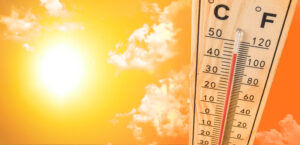What happens to us when the human body is exposed to extreme heat?
As you know, the body is an amazing organism and it has two important ways to cool down when your body has extreme heat exposure:
- The first mechanism is sweat. Sweat glands on the skin secrete sweat and when it evaporates off the body, it cools down the skin.
- Increased blood flow is the second mechanism. The brain redirects blood flow from the core of the body to the skin where heat can be released. The evaporating sweat helps cool the blood in the skin and that cooled blood is recirculated to the internal organs which cools down the body core.
There are two factors that can disrupt this natural cooling process in your body:
- When the temperature outside your body is hotter than your skin temperature, which is around 95 degrees, your skin will take in heat vs releasing heat into the atmosphere.
- Also, if it’s too humid, the sweat on your skin can’t evaporate to provide cooling so the body no longer has that cooling mechanism.
What does your body do when these processes no longer work because it’s too hot and/or humid?
- The heart works a lot harder because the heart rate increases in an effort to push more blood out to the skin to cool the body.
- The BP drops because as the blood gets pushed to a wider surface area to provide cooling and the blood pressure gets weaker as it gets moved out to further areas in the body.
- The increased heart rate can really tax the heart, so if someone has a pre-existing heart condition, it can be fatal.
Heat exhaustion otherwise known as Heat Stress, is the first problem that can begin when getting overheated
During heat exhaustion, the internal temp in body rises to 100 to 103 degrees.
The first symptoms that occur in heat exhaustion include:
- Fatigue
- Poor muscle function
These early symptoms are messages from your brain to tell you to rest and cool down
Other symptoms include:
- nausea
- feeling faint or having the sense that you are going to black out
- sweating profusely from many areas of the body
- moist, cool, or cold skin, coupled with goose bumps, even in extreme heat
- a pulse rate that becomes weak and rapid
- headache
- muscle cramping
What is the difference between Heat Exhaustion and Heat Stroke?
The body does a really good job to try to cool you off, but if these mechanisms to cool down start to fail, the body temperature continues to rise.
I mentioned earlier that heat exhaustion occurs when the body temperature is 100 to 103 degrees Fahrenheit. Heat stroke occurs when the body temperature reaches 104 Degrees Fahrenheit or higher. At this point, multi organ failure can happen. The organs that are affected first are the heart, kidneys, gut and brain.
Heart– Your heart is pumping very hard to help you cool off and as the HR increases, BP drops and as a result oxygen is not getting to the organs, including to the heart itself.
The kidneys are impacted because the brain sends a signal to the body to send less blood to the kidneys to slow the dumping of liquid via urine in order to preserve as much liquid as possible. The reduced blood flow results in reduced oxygen to the kidneys leading to kidney failure.
Gut– Blood is diverted from the gut, decreasing oxygen to the gut, and when that happens, the gut starts to fail and leaky gut occurs which is when bacteria leaks from the gut and can cause sepsis.
Brain– Once the brain is affected, things get really dire. The body’s internal thermometer is in the part of the brain called the hypothalamus. Once this part of the brain is affected, the cooling mechanism message from the brain shuts down and the body temp continues to rise. The skin gets clammy and cool, delirium begins.
WHAT TO DO? The fastest way to cool people off when they are experiencing heat stroke is an ICE BATH. This is what they use in the Emergency Department.
If you suspect that someone is suffering from HEAT STROKE the first thing to do is to contact emergency medical services (EMS) immediately.
Before starting an ice bath, assess the person’s airway and circulation. Make sure they are breathing and have a pulse.
- Move the person to a shaded area.
- Half fill a tub or wading pool with water and ice. Ice should cover the surface of the water at all times.
- Cover as much of the body as possible (but not the head) with ice water. If complete coverage is not possible, cover the torso as much as possible.
- Keep the neck and head above the water. Place a towel soaked in ice water over the head and neck while the body is being cooled. Do not block the airway, keep the towel off the nose and mouth.
- Vigorously circulate water throughout the cooling process.
If ice water immersion is not feasible given the constraints of the environment, and on-site cooling is appropriate, then cool the person using the best available means. This may include ONE of the following three methods:
- Fill a cooler with ice, water, and 12 towels. Place six icy wet towels all over the person’s body. Leave them in place for two to three minutes, then place those back in cooler and replace them with the six others. Continue this rotation every two to three minutes. **OR**
- Douse the patient continuously with cold water using a shower or hose. **OR**
- If ice is available but no tub, place the person in a tarp or sheet, cover the person with a large amount of ice, and then wrap the tarp or sheet around them. Replenish the ice as soon as a moderate degree of melting occurs. Remember to keep the tarp or sheet OFF of the nose or mouth to make sure the airway is clear.
We can’t change the weather and our planet is getting hotter and hotter. However, there are some practical behavioral methods we can implement to reduce the risk for heat exhaustion when it’s hot outside.
- Stay in a cool place when the heat index climbs. If you don’t have air conditioning at home, find out if there’s a cooling center in your area. Public libraries, malls, and movie theaters are also usually air-conditioned and may provide some relief during the hottest parts of the day.
- Never, never, never leave a child or baby or pet in a hot car, even for a few minutes. Temperatures in cars can rise rapidly.
- Wear lightweight and light-colored clothing. Dark colors attract and absorb heat, which may increase your body temperature. Even better, you can get lightweight and light colored clothing that has a high UPF to protect you from UV rays as well!
- Wear a lightweight sunhat if you’re going to be in the sun. Keeping the sun off of your head and face can help control your body temperature.
- Wear sunscreen when in the sun to avoid sunburn. Having a sunburn increases your risk of having heat exhaustion or heat stroke.
- Stay hydrated when it’s hot outside. Your body can become dehydrated before you notice signs. Keep a bottle of water with you and drink from it frequently. You can also have something like NUUN tabs with you to drop into your water bottle to provide electrolyte replacement if you’re sweating.
- When it’s hot outside, limit outdoor workouts to early morning or dusk, or consider joining a gym that has air conditioning. Swimming is also a great way to get exercise when it’s hot outside.
PLEASE STAY SAFE by implementing these measures during hot weather!!




